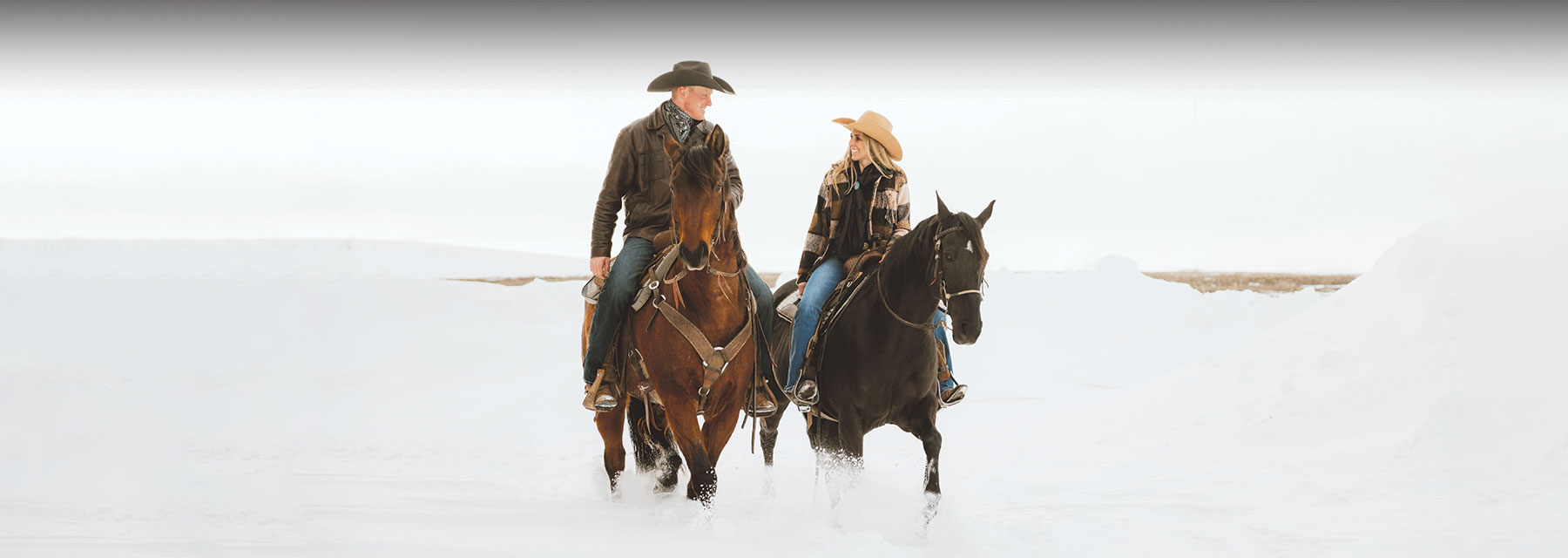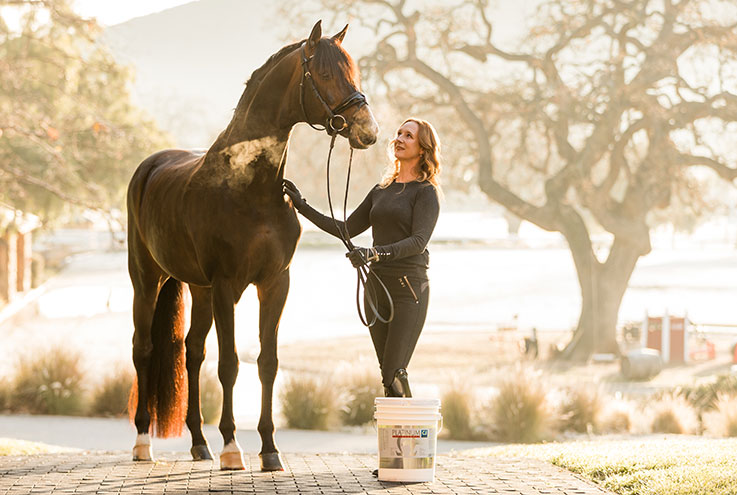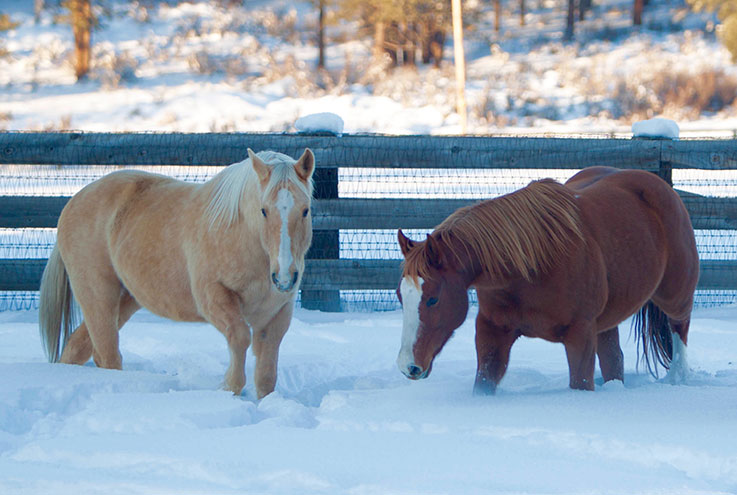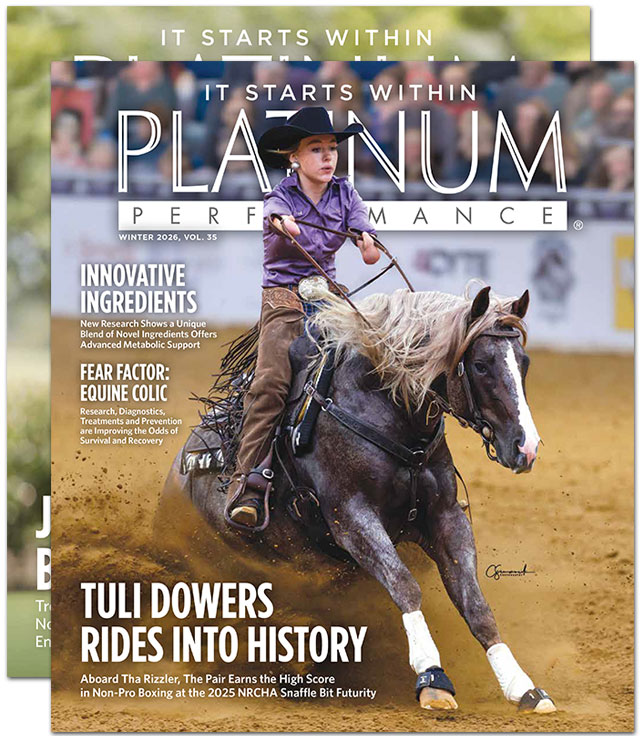Tips for a Healthy, Enjoyable Winter
Horses are very capable of thriving in cold temperatures. By avoiding a few cold-weather pitfalls and some helpful caregiver intervention, our equine partners can enjoy a healthy and happy winter.
HYDRATION STATION: Water
Dehydration is the biggest health risk during winter, and inadequate water intake is the No. 1 colic risk factor. In mild temperatures, a horse will drink 6-10 gallons per day. Having fresh, clean water available is critical. Cold water temperatures are correlated to a decrease in water consumption.
- Ideally, water should be heated to 45-65 degrees, a temperature range that studies have found maximizes equine water consumption.
- If heating water is not an option, make sure the water sources are not frozen over and top off with hot water several times a day.
- Including salt in feed can help to increase water consumption. Top dress one tablespoon of white table salt onto each feeding.
HANDS ON: Body Condition
It is important to consistently gauge your horse’s body condition. With their thick, winter coats, simply looking at the horse can be deceiving. Running your hands over the animal weekly will give you a clearer idea of body condition changes and if feed adjustments are needed.
- The recommended body condition score (BCS) for most horses is in the 4-6 range on the Henneke Body Condition scale, which uses a scale of 1-9 to describe six key anatomical points.
- A BCS of less than 4 is considered thin, and more than 6 is overweight.
- Keeping a log of approximate weight using a weight tape and body condition will allow you to make caloric adjustments early and keep your horse in a healthy weight range.
Researchers at the University of Pennsylvania's School of Veterinary Medicine found that in cold weather, horses drank almost 40% more water if it was warmed up to 45-65 degrees versus colder water of 32-38 degrees.
WINTER WEIGHT: Hard Keepers
Some horses — hard keepers and some senior horses — are prone to winter weight loss. Typically, horses should consume about 2% of their body weight in total feed (hay and concentrate) per day. For an average 1,000-pound horse, that equates to 20 pounds of feed daily.
- Horses burn calories regulating their body temperatures to keep warm. However, hay, more than grain, generates internal heat via the fermentation process that digests fiber-based forages in the large intestine. Consuming hay actually helps raise a horse’s core body temperature.
- If your horse is thin going into winter or struggles to maintain weight in the cold, aim for closer to 3% of body weight in feed, the majority from quality hay placed in front of them around the clock.
WINTER WEIGHT II: Easy Keepers
On the other hand, some horses are less active in winter, easily holding their weight or even gaining pounds.
- If your horse tends to bulk up over winter and needs to cut calories in the cold, make sure you aren’t eliminating essential nutrients too.
- Provide hay in a slow feeder to keep their gastrointestinal motility consistent, cut the grain and use a comprehensive wellness supplement or a balancer to ensure the diet includes necessary protein, omega-3 fats, vitamins and minerals.
Jack Frost's Tip for Fat Horses
If your horse is less active in winter and gaining too much body condition, try reducing or eliminating grains and sweet feeds that contain more calories per pound as well as higher levels of starch and sugar than forage.
- Use grass hay as the bulk (or all) of the diet.
- Hay can also be reduced to 1.5% of the horse's bodyweight, and put it in a slow feeder to allow slow high-fiber consumption throughout the day.
- Weigh all of your feeds, so you know exactly how much you provide each day and can avoid overfeeding calories.
APPLE-A-DAY: Wellness
Horses may need a few vital nutrients supplemented during winter. Omega-3 fatty acids and vitamin E — abundant in fresh grass — will need to be added to the daily diet, particularly if the horse is receiving hay only or if snow is covering the grass.
- Cold weather and decreased activity can cause occasional discomfort. Adequate turnout, mild exercise with plenty of warmup time and a supplement providing glucosamine, hyaluronic acid, MSM, ASU and cetyl myristoleate can support joint health and comfort.
- With the increased occurrence of gastrointestinal issues linked to decreased water intake, a pre- and probiotic is recommended.
- Plain, white salt should be available to support healthy water consumption. Add 1 to 2 tablespoons of salt to the daily feed.
WIND BREAKER: Shelter
The equine hair coat provides excellent insulation in the cold, and horses are able to withstand even below-freezing temperatures quite well. However, precipitation and winter winds can disturb the natural insulation.
- A barn or run-in shelter provides protection and an option for horses to retreat from extreme elements.
- Some prefer to shelter their horses in stalls during wind, snow or slushy conditions. However, healthy horses with a good hair coat and in appropriate body condition also do well with a well-ventilated, simple three-sided shelter.
Keep in Mind
Omega-3 fatty acids and vitamin E — abundant in fresh grass — will need to be added to the daily diet, particularly if the horse is receiving hay only or if snow is covering the grass.
Old Man Winter’s Checklist
 Offer warmed water, ideally 45-65 degrees to encourage drinking
Offer warmed water, ideally 45-65 degrees to encourage drinking Evaluate body condition regularly and adjust feeding as needed
Evaluate body condition regularly and adjust feeding as needed Provide extra hay during extreme cold, which will help keep your horse warm
Provide extra hay during extreme cold, which will help keep your horse warm Supplement plain, white salt and an omega-3 and antioxidant wellness formula
Supplement plain, white salt and an omega-3 and antioxidant wellness formula Make sure to provide a shelter option for wind and precipitation protection
Make sure to provide a shelter option for wind and precipitation protection Encourage ventilation by keeping barn doors and windows open for stalled horses
Encourage ventilation by keeping barn doors and windows open for stalled horses
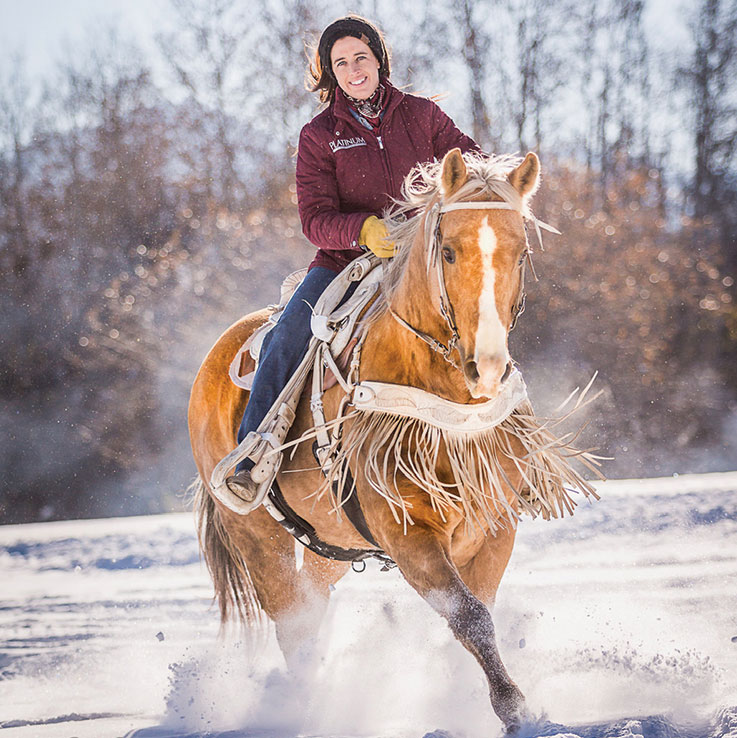
Madison MacDonald has been a Platinum Performance client since 2001.
EBBIE HANSEN, ROCKEN ZEN RODEO PHOTOGRAPHY
SWEATER WEATHER: Blanketing
Many with a full winter coat thrive throughout the season, but others may need an indoor stall and blanketing. Blankets are a valuable tool — thin horses and very young or old horses — and provide an extra layer of warmth to conserve core body temperature and fewer calories spent on warmth.
- Blanketing may benefit horses turned out without a shelter option or if the temperatures or wind chill drop below zero.
- If wet weather is expected, a waterproof blanket can help.
- Performance horses or any horse that has been body clipped and has had their natural protection removed will require blanketing.
- Take off the blanket and groom your horse regularly. Make sure the blanket allows plenty of circulation to maintain a healthy hair coat.
FRESH AIR: Ventilation
Many horses spend winters outside, but there are plenty that spend more time in barn stalls. It is important to provide a well-ventilated indoor environment to prevent respiratory problems. Minimizing dust, mold, ammonia fumes and other allergens will decrease the incidence and severity of skin problems and inflammatory airway issues.
- Consider hay storage areas and check for dust and mold. Ideally, hay should not be stored in the same space as the horse.
- If hay is dusty, wet it down right before feeding.
- Barns kept tightly closed are more likely to have air quality issues and circulate stale, musty air. Encourage airflow by frequently opening doors and windows. Turn out horses during barn chores.
